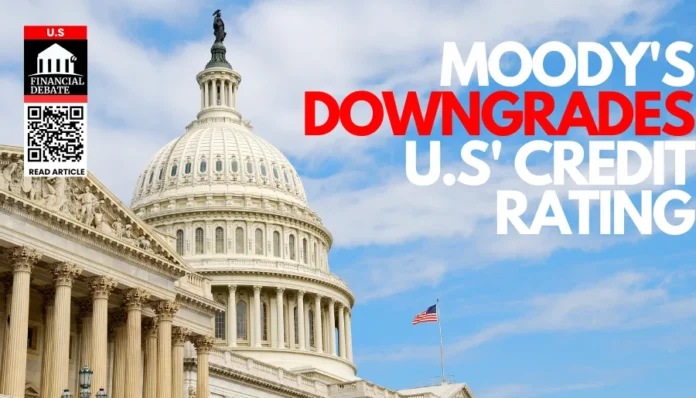- Moody’s has lowered the United States’ credit rating from the highest level (Aaa) to Aa1 due to growing federal debt and ongoing budget deficits.
- The downgrade reflects concerns about rising interest costs, entitlement spending, and insufficient government revenue, projecting debt to reach 134% of GDP by 2035.
- Despite the downgrade, the U.S. Treasury remains optimistic, highlighting the economy’s strength and plans to manage spending and promote growth.
Introduction: A Historic Credit Rating Change
For the first time in history, the United States has lost its triple-A credit rating from all three major rating agencies. Moody’s Investors Service recently downgraded the U.S. credit rating from Aaa, the highest possible, to Aa1. This shift signals growing worries about the country’s financial health, especially the rising national debt and persistent budget deficits. The downgrade is a significant event because a top credit rating typically means the government can borrow money at lower interest rates, reflecting trust in its ability to repay debts.
Why Did Moody’s Downgrade the U.S.?
Moody’s decision was influenced by several key factors:
- Rising Federal Debt: The U.S. federal debt is expected to grow from about 98% of the country’s Gross Domestic Product (GDP) in 2024 to nearly 134% by 2035. This means the government’s debt will be much larger compared to the size of the economy.
- Increasing Interest Payments: As debt grows, so do the costs to pay interest on that debt. Moody’s warns that these payments will consume a larger share of the federal budget, leaving less money for other priorities.
- Entitlement Spending: Programs like Social Security, Medicare, and Medicaid are major parts of government spending. With an aging population, costs for these programs are rising faster than revenues.
- Insufficient Revenue: The government’s income from taxes and other sources is not keeping pace with spending, leading to bigger deficits each year.
Moody’s noted that these issues have not been effectively addressed by past administrations or Congress, which has led to a worsening fiscal outlook compared to other countries with high credit ratings.
How Does This Compare to Previous Downgrades?
This downgrade by Moody’s follows similar actions by Fitch Ratings in 2023 and Standard & Poor’s back in 2011. Together, these moves mean the U.S. no longer holds a triple-A rating from any of the main agencies. While this might sound alarming, Moody’s has changed its outlook from “negative” to “stable.” This suggests that although there are concerns, Moody’s believes the situation may not worsen rapidly.
One reason for this more stable outlook is the strength of the U.S. economy and the U.S. dollar’s role as the world’s primary reserve currency. These factors help maintain investor confidence despite fiscal challenges.
Government’s Response: Downplaying the Downgrade
Scott Bessent, the U.S. Treasury Secretary, responded to Moody’s downgrade by minimizing its importance. He described the rating cut as a “lagging indicator,” meaning it reflects past government spending decisions rather than current or future policies. Bessent pointed out that much of the spending that led to the downgrade happened during the Biden administration’s first four years, which the current administration inherited.
He expressed confidence that ongoing efforts to reduce spending and stimulate economic growth will help manage the debt. According to Bessent, these policies will allow the economy to grow faster than the debt, improving the fiscal situation over time.
Bessent also argued that the downgrade would not harm investor confidence or international trade negotiations. He highlighted ongoing agreements and talks that show global partners still trust the U.S. economy.
Political Context: Tax Cuts and Fiscal Debates
The downgrade comes at a time of heated political debate over fiscal policy. Republicans, led by former President Donald Trump, are advocating for large tax cuts similar to those passed in 2017. Supporters argue these cuts will boost economic growth, but critics worry they will increase budget deficits and debt.
Moody’s has warned that further tax cuts without spending cuts could worsen the fiscal outlook. Fiscal conservatives in Congress are concerned that such policies might deepen the debt problem rather than solve it.
What Does This Mean for the Average Citizen?
A credit rating downgrade can have real-world effects, even if they are not immediately obvious:
- Higher Borrowing Costs: When the government’s credit rating drops, it may have to pay higher interest rates to borrow money. This could eventually lead to higher taxes or reduced government services.
- Economic Uncertainty: Investors may become more cautious, which can affect stock markets and economic growth.
- Long-Term Fiscal Challenges: Without changes to spending and revenue policies, the growing debt could limit the government’s ability to respond to future crises, such as recessions or emergencies.
Conclusion: A Wake-Up Call for Fiscal Responsibility
Moody’s downgrade of the U.S. credit rating to Aa1 is a clear signal that the country’s financial path is unsustainable without changes. While the U.S. economy remains strong and the dollar continues to dominate global markets, the growing debt and deficits present serious challenges.
The downgrade should serve as a wake-up call for policymakers to take meaningful steps to manage spending, reform entitlement programs, and ensure the government’s long-term fiscal health. How the U.S. responds in the coming years will be crucial for maintaining economic stability and global confidence.
